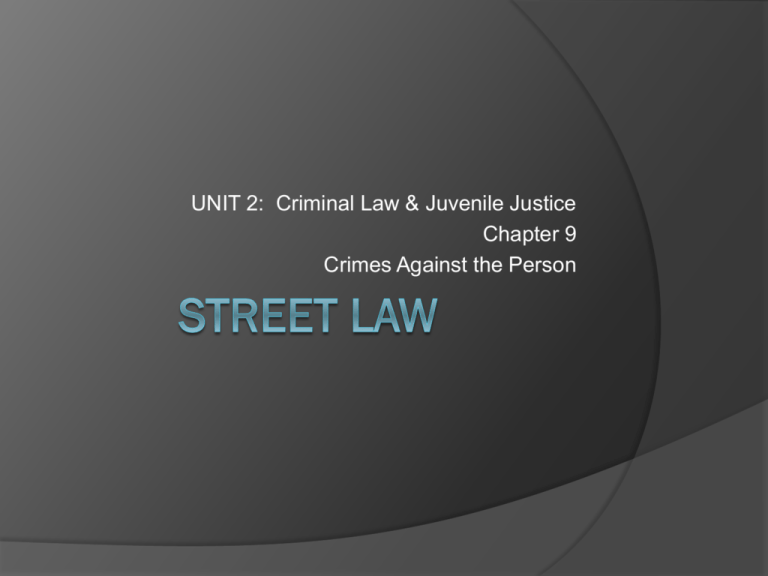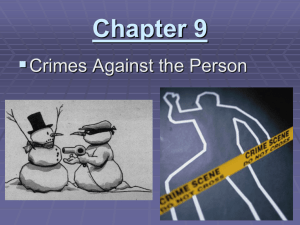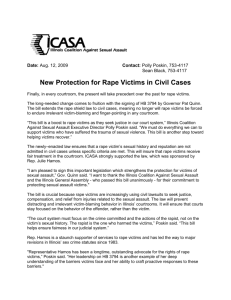
UNIT 2: Criminal Law & Juvenile Justice
Chapter 9
Crimes Against the Person
Crimes against the person include
Homicide
Assault/Sexual Assault
Battery
Rape
Kidnapping
False Imprisonment
Mayhem
They are all serious offenses that can result
in harsh punishments
Various levels of these crimes have been
defined by law in order to protect the
defendant from overly harsh penalties
In addition, the circumstances of each
offense are considered in sentencing
Varying circumstances may influence the severity
of the sentence
Homicide
Homicide—the killing of one human being by
another—is considered the most serious of all
acts
It can be classified as criminal or non-criminal
Criminal homicide is committed with intent, or a plan
It is also considered criminal homicide if a person’s
reckless actions, w/o regard for human life, result in the
killing of another person
Noncriminal homicide can be classified as either
“excusable” or “justifiable,” & is not subject to criminal
charges
Homicide Crimes
Murder/Felony Murder
Manslaughter
Negligent Homicide
Vehicular Homicide
Criminal Homicide
Murder
Killing that is done with malice
(the most serious form)
○ Malice means having the intent to kill or seriously harm
another person or acting in an extremely reckless manner
which shows a lack of regard for human life
It may be classified as first-degree, felony murder, or
second-degree, depending on
○ the level of premeditation,
○ the killer’s state of mind, and/or
○ the circumstances that preceded the crime
First-degree murder
Killing that is
○ premeditated (thought about beforehand),
○ deliberate,
○ & done w/malice
An action w/an intent to kill or cause severe bodily
injury or w/a depraved indifference to human life
Premeditation & deliberation can occur very close
to the time of the homicide
Felony murder
Any killing that takes place during the commission
of certain felonies, such as arson, rape, robbery, or
burglary
Not necessary to prove intent
Malice is presumed because the homicide
occurred during the felony—even if the killing was
accidental
Most states consider felony murder to be 1st
degree murder
Second-degree murder
Killing that is done w/malice, but w/o premeditation
or deliberation
The intent to kill didn’t exist until the moment of the
murder
Includes intentional but spontaneous killings that
are unplanned
Voluntary manslaughter
Killing that would otherwise be murder, but that occurs after
the victim has done something to the killer that would cause
a reasonable person to lose self-control or act rashly
○ Killing someone in a violent argument w/o 1st planning to do so
○ Words alone (no matter how offensive) don’t reduce the severity
of murder to voluntary manslaughter
○ The killing must occur just after the provocation so that the killer
didn’t have an opportunity to “cool down”
A person discovers his/her spouse w/someone else & that person kills
the spouse’s lover in a jealous rage
Punished less severely than murder as a concession to the
frailty of human character
Involuntary manslaughter
Killing in which there is no intent to kill at all
○ Unintentional killing resulting from conduct so
reckless that it causes extreme danger of death or
bodily injury
Killing that results from playing w/a gun known to be loaded
Negligent homicide
Causing death through criminal negligence
○ Negligence is the failure to exercise a reasonable or
ordinary amount of care in a situation, thereby
causing harm to someone
Vehicular homicide—killing that results from operating a motor
vehicle in a reckless & grossly negligent manner
- Any death that results from careless driving may lead to a
civil suit for damages, but it is usually not considered a
crime unless the death results from gross negligence
Non-criminal Homicide
Killing that is justifiable or excusable & for
which the killer is deemed faultless
The killing of an enemy soldier in wartime
The killing of a condemned criminal by an
executioner
The killing by a police officer of a person who is
committing a serious crime & who poses a threat of
death or serious harm
A killing performed in self-defense or in defense of
another person
Suicide
The deliberate taking of one's own life
Was once considered a crime—now prohibits only
attempted suicide
Most courts generally treat attempted suicide as
a plea for help & demand that the individual seek
treatment
The courts may order a psychological
examination or treatment for someone who has
attempted suicide
Someone who helps another person commit
suicide can, however, be found guilty of the
crime of murder or manslaughter
Statistics
Suicide took the lives of 29,350 Americans in
2000
An average of 10.6 out of every 100,000
persons died by suicide
The total number of suicides was 29,350
(1.2 percent of all deaths)
More people die from suicide than from
homicide
In 2000, there were 1.7 times as many
suicides as homicides
Overall, suicide is the 11th leading cause of
death for all Americans, & is the 3rd leading
cause of death for young people ages 15 to
24, behind unintentional injury & homicide
19% of teens in grades 9-12 reported seriously
considering suicide (2001)
15% made a plan to commit suicide
9% attempted suicide
On average, a HS student succeeds in killing
him/herself every 15 minutes
Persons under age 25 accounted for 15
percent of all suicides in 2000
Suicide rates increase with age & are highest
among Americans ages 65 years & older
In 2000, firearms were the most common
method of suicide by both males & females
Males are more than 4X more likely
(8th leading cause of death in 2000)
to die from suicide than are females
(19th leading cause of death)
However, females are 3X more likely to
attempt suicide than males
During the period from 1979-1992, suicide
rates for Native Americans were about 1.5X
higher than the National rate
“Native Americans” is a category that includes
American Indians & Alaska Natives, with males
ages 15 to 24 accounting for 64% of all suicides by
Native Americans
In 2000, suicide among white & African
American males was significantly higher than
for females of the same race
However, overall suicide rates for both white
males & females were greater than those for
African American males & females
Although white teens still have a higher rate
of suicide, the gap is narrowing
Suicides by gay, lesbian, bisexual, &
transgender teens are substantially higher than
other groups of teens
Often, the internalization of society’s negative, hostile,
& degrading attitude toward gay, lesbian, bisexual, &
transgender individuals leads to feelings of despair,
low self-image, low self-esteem, substance abuse, &
depression
These risk factors are usually more profound within
this group, thus doubling the already alarming
likelihood of suicidal behavior & suicide, which already
exists among heterosexual youth
Strategies
If you suspect that someone you know is
considering suicide:
Always take a person who talks about suicide
seriously
Do not enter into any secret pacts—if a friend
asks you not to tell anyone, respond that you care
too much not to tell someone
If you are afraid that telling someone might ruin
your friendship, remember that not having the
friend around at all would be far worse
Tell someone! This could be a teacher, counselor,
parent, or other trusted adult
Realize that you are not trained to handle this kind
of situation, so it is best to put it into the hands of
someone who is
Encourage the person who is considering suicide
to make concrete plans for the future, including
the next time you will see each other
Making plans with him or her for a future date will
provide the person with comfort, hope, & direction
It may also provide some time for the person to
get professional help
Above all—remember that you can only do so
much
If a person truly wants to take his or her life, there
is really no way to prevent it—the final decision is
that of the individual
Assault & Battery
The law often treats assault & battery as very similar
crimes
Assault—an attempt or threat to carry out a physical attack
upon another person
Battery—any unlawful physical contact inflicted by one
person upon another person without consent
○ Even if actual injury does not occur, a person may be charged
with battery if he or she intended to harm the other person
○ Aggravated battery is often defined by the harm inflicted—an
unarmed assault that results in a serious physical injury is an
aggravated battery rather than a simple assault
These crimes—which include simple assault,
stalking, & sexual assault—are classified according
to how severe they are
Stalking
Occurs when a person repeatedly follows or
harasses another person & makes threats, causing
the victim to fear death or bodily injury
Women are most often the targets
Most states have anti-stalking laws
Sexual assault
A specific kind of assault that can include rape or
attempted rape
Includes a wide range of victimizations from verbal
threats of a sexual nature to unwanted sexual
contact
Can be an attack that is either completed or
attempted
○ May include grabbing, & may, but does not have to,
involve force
Rape
The law generally has recognized rape &
statutory rape as separate crimes
Rape—sexual intercourse w/o consent
○ Aggravated rape occurs when the perpetrator uses
a weapon or some other form of force to compel the
victim to have intercourse
○ There is no consent if the victim is unconscious or
mentally incompetent or if drugs or alcohol impair
the victim’s judgment
Statutory rape—intercourse between an adult & a
minor
○ Lack of consent is not an element of the crime
○ The crime is based on the notion that a minor is
incapable of giving legal consent
○ A male can be prosecuted for statutory rape with a
minor even if the female lied about her age
Rape laws recognize that either males or
females can commit or be victims of this crime
This area of law is in transition, however, as
many states are replacing their rape laws with
criminal sexual assault laws
When the victim is under a certain age, over a
certain age, disabled, or threatened with a
weapon, punishment may be more severe
Young people are more likely to be victims of
rape than any other age group
Between 1/4 & 1/3 of the rape victims each
year are 12 - 19 years old
Roughly 1 in 6 women report that they
experienced a rape or attempted rape
Rape is believed to be one of the least
reported crimes
Male rape victims have been even more reluctant
to report this crime to the police
Approximately 10% of rape victims are boys or
men
Approximately 3% of American men have been
victims of rape or attempted rape in their lifetime
Reasons Why People Are
Reluctant to Report Rape
Many people feel embarrassed or ashamed
after being the victim of rape
Some people fear that they will be treated
insensitively by those who investigate their
claim
In response, many police departments have
created special units to investigate sex crimes
& to refer victims to social services agencies
that can offer support
Some people believe the criminal justice
systems has a poor record regarding rape
prosecutions
Many times prosecutors are reluctant to
pursue a case in which the victim knows the
assailant because they do not believe they
can win the case
Some people worry that a trial might bring
back difficult memories & subject them to
invasive questions
In some states, victims may be subject to
tough cross-examination by defense
attorneys, including questioning about their
prior sexual conduct
The trend has been to be more protective of
victims—that is, to make sure the defendant &
not the victim is put on trial
Attorneys do this in an attempt to establish
that a victim’s past sexual relations with
other persons are relevant to whether or not
the victim consented
The trend, by court decision & statute, is to rule
evidence of past sexual relations with persons
other than the defendant as irrelevant
Many states have enacted “rape shield” laws
to protect victims from this type of
questioning
Some people feel further victimized because, to
obtain a conviction, some state laws also require
other evidence, called corroboration, in addition
to the testimony of the victim
This means confirmation or support for the story of the
victim, including testimony of a witness, a doctor’s
report that sexual intercourse took place, or a prompt
report to the police
These laws have been criticized by those who
argue that it should not be more difficult to get a
conviction for rape than for any other crime
Acquaintance rape
AKA date rape—a sexual assault by someone
known to the victim
Many victims don’t report the assault—this may be
because they do not realize an attack that occurs
on a date can in fact constitute a rape
Differing State Laws
Some state laws are gender-neutral; others
only protect females from rape &/or statutory
rape
Some states don’t allow the prosecution of
one spouse who forces the other to have sex
States have different interpretations of what
constitutes statutory rape









